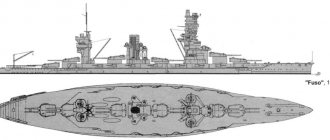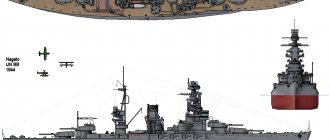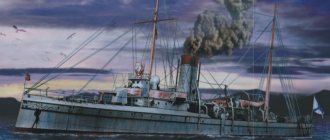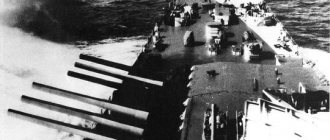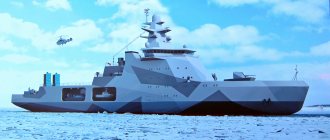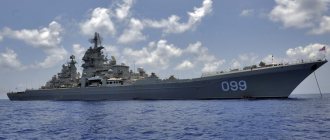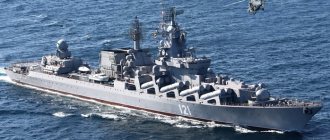Cruisers | Japan
Battlecruiser Kongo
Battlecruiser Hiei
Battlecruiser "Kirishina"
Battlecruiser Haruna
The series of Kongo-class cruisers consisted of 4 units (“Kongo”, “Hiei”, “Kirishina”, “Haruna”). The cruiser Kongo was built at the Vickers Shipbuilding Company in the UK and entered service in 1913. The Hiei was built at the Yokosuka Naval Arsenal shipyard and commissioned in 1914. The cruiser Kirishina was built at Mitsubishi ", and "Haruna" to "Kawasaki". Both ships were commissioned in 1915. The first modernization of the ships was in 1927-1931, the second in 1932-1933. the third - in 1933-1940. The cruisers Hiei and Kirishina were lost in 1942, and the Kongo and Haruna in 1944 and 1945. respectively. Performance characteristics of the ship: standard displacement - 31.7 - 32.3 thousand tons; full - 38.2 - 38.9 thousand tons; length – 220 m; width – 29.3 m; draft - 9.7 m; speed - 30.3 knots; power plants - 4 steam turbine units and 8-11 steam boilers; power – 136 thousand hp; fuel reserve – 6.3 thousand tons of oil; cruising range - 10 thousand miles; crew – 1,440 people. Reservation: side – 203 – 76 mm; traverses – 203 mm; towers and barbettes – 229 mm; deck – 80 – 120 mm; casemates - 152 mm. Armament: 4x2 – 356 mm guns; 14x1 - 152 mm guns; 4x2 – 127 mm guns; 10x2 - 25 mm anti-aircraft guns, catapult and 3 seaplanes.
Heavy cruiser Furutaka
The Furutaka class cruiser series consisted of 2 units (Furutaka, Kako) and was commissioned in 1926. The Furutaka cruiser was built at the Mitsubishi shipyard, and Kako at Kawasaki. In 1931-1933 The ships' anti-aircraft artillery was updated. In 1936-1939 The cruisers were modernized with a complete replacement of weapons. Both cruisers were lost in 1942. Performance characteristics of the ship: standard displacement - 8.7 thousand tons; full – 11.1 thousand tons; length – 176 m; width – 17 m; draft – 5.6 m; speed - 33 knots; power plants - 4 steam turbine units and 10 steam boilers; power – 103 thousand hp; fuel reserve – 1.8 thousand tons. oil; cruising range - 7.9 thousand miles; crew – 640 people. Reservation: side – 76 mm; towers and barbettes – 25 mm; deck - 32 - 35 mm. Armament: 3x2 - 200 mm guns; 4x1 - 120 mm guns; 4x2 – 25 mm anti-aircraft guns; 2x2 - 13.2 mm machine guns, 2x4 - 610 mm torpedo tubes, catapult and 2 seaplanes.
Heavy cruiser "Aoba"
Heavy cruiser Kinugasa
The “Aoba” class cruiser series consisted of 2 units (“Aoba”, “Kinugasa”) and was commissioned in 1927. The “Aoba” cruiser was built at the Mitsubishi shipyard, and the “Kinugasa” - at Kawasaki " In 1938-1940 the ships have undergone modernization. The cruiser "Kinugasa" was lost in 1945, and "Aoba" - in 1945. Performance characteristics of the ship: standard displacement - 9 thousand tons; full – 11.5 thousand tons; length – 177 m; width – 17.6 m; draft – 5.7 m; speed - 33 knots; power plants - 4 steam turbine units and 12 steam boilers; power – 110 thousand hp; fuel reserve – 2 thousand tons. oil; cruising range - 8 thousand miles; crew - 660 people. Reservation: side – 76 mm; towers and barbettes – 25 mm; deck - 32 - 35 mm. Armament: 3x2 - 203 mm guns; 4x1 - 120 mm guns; 4x2 – 25 mm anti-aircraft guns; 2x2 - 13.2 mm machine guns, 2x4 - 610 mm torpedo tubes, catapult and 2 seaplanes.
Heavy cruiser "Myoko"
Heavy cruiser Haguro
Heavy cruiser Ashigara
The Myoko class heavy cruiser series consisted of 4 units (Myoko, Nachi, Haguro, Ashigara) and was built by the Yokosuka Naval Arsenal, Kure Naval Arsenal, Mitsubishi and Kawasaki shipyards " respectively. The ships were commissioned in 1928-1929. In 1934-1936. the ships underwent the first modernization in 1939-1941. - second. Both modifications were aimed at updating weapons. The cruiser "Nachi" was lost in 1944, "Haguro" and "Ashigara" - in 1945, and "Myoko" was sunk in 1946. Performance characteristics of the ship: displacement - standard 12.3 thousand tons, total - 16 thousand. T; length – 192 m, width – 20.7 m; draft – 6.3 m; speed - 33.8 knots; power plants - 4 steam turbine units and 12 steam boilers; power – 130 thousand hp; fuel reserve – 2.2 thousand tons. oil; cruising range - 7.5 thousand miles; crew - 890 people. Reservation: side – 102 mm; traverses – 75 – 100 mm; towers – 25 mm; barbettes – 75 mm; deck - 32 - 35 mm. Armament: 5x2 - 203 mm guns; 4x2 - 127 mm guns; 4x2 – 25 mm anti-aircraft guns; 2x2 - 13.2 mm machine guns, 4x4 - 610 mm torpedo tubes, 2 catapults and 3 seaplanes.
Heavy cruiser "Takao"
Heavy cruiser Atago
Heavy cruiser Chokai
Heavy cruiser Maya
The Takao class heavy cruiser series consisted of 4 units (Takao, Atago, Chokai, Maya) and was commissioned in 1932. Takao and Atago were built at the Yokosuka shipyard Navy Yard", "Chokai" - on Mitsubishi, and "Maya" - on Kawasaki. In 1938-1939 The cruisers Takao and Atago were modernized. During the period of repairs, the ships' anti-aircraft artillery was updated. The cruiser "Takao" sank in 1945, the rest died in 1944. Performance characteristics of the ship: standard displacement - 11.4 - 13.4 thousand tons, total displacement - 13.9 - 15.6 thousand tons; length – 192 m; width – 20.7 m; draft – 6.3 m; speed – 34.3 – 35.5 knots; power plants - 4 steam turbine units and 12 steam boilers; power – 130 thousand hp; fuel reserve – 2.3 – 2.6 thousand tons. oil; cruising range – 8 – 8.5 thousand miles; crew - 900 - 920 people. Reservation: side – 102 mm; traverses – 75 – 100 mm; towers – 25 mm; barbettes – 75 mm; deck – 32 – 35 mm; cutting 16 mm. Armament: 5x2 - 203 mm guns; 4x1 - 120 mm guns; 6x2 - 25 mm anti-aircraft guns or 2x2 -25 mm anti-aircraft guns and 2x2 - 13.2 mm machine guns; 4x4 - 610 mm torpedo tubes, 2 catapults and 3 seaplanes.
Heavy cruiser "Mogami"
The series of heavy cruisers of the "Mogami" type consisted of 4 units ("Mogami", "Mikuma", "Suzuya", "Kumano"). The ships were built at the Kure Naval Arsenal, Mitsubishi, Yokosuka Naval Arsenal and Kōbe-Kawasaki shipyards, respectively. The cruisers Mogami and Mikuma entered service in 1935, and Suzuya and Kumano in 1937. In 1937-1938. The Mogami and Mikuma had their hulls modernized and their weapons updated. In 1942-1943. "Mogami" was converted into an aircraft-carrying cruiser - two stern towers were removed and storage space for 11 seaplanes was equipped. The cruiser "Mikuma" was lost in 1942, the rest in 1944. Performance characteristics of the ship: standard displacement - 12.4 thousand tons, full displacement - 15.1 thousand tons; length – 189 m; width – 20.2 m; draft - 5.9 m; speed – 35 knots; power plants - 4 steam turbine units and 10 steam boilers; power – 152 thousand hp; fuel reserve – 2.2 thousand tons. oil; cruising range - 7 thousand miles; crew - 850 people. Reservation: side – 100 – 140 mm; towers – 25 mm; deck – 35 – 60 mm; cutting 100 mm. Armament: 5x2 - 203 mm guns; 4x2 - 127 mm guns; 4x2 – 25 mm anti-aircraft machine gun, 2x2 – 13.2 mm machine gun; 4x3 - 610 mm torpedo tubes, 2 catapults and 3 seaplanes.
Heavy cruiser Chikuma
The Tone-class series of heavy cruisers was built at the Mitsubishi shipyard and consisted of 2 units (Tone, Chikuma). The ships were commissioned in 1938-1939. By 1942, the anti-aircraft artillery on the cruisers was updated. The cruiser "Tone" died in 1945, and "Chikuma" - in 1944. Performance characteristics of the ship: standard displacement - 11.2 thousand tons, full displacement - 15.2 thousand tons; length – 189 m; width – 19.4 m; draft – 6.5 m; speed – 35 knots; power plants - 4 steam turbine units and 8 steam boilers; power – 152 thousand hp; fuel reserve – 2.7 thousand tons. oil; cruising range - 8 thousand miles; crew - 870 people. Reservation: side – 100 – 145 mm; towers and barbettes – 25 mm; deck – 30 – 65 mm. Armament: 4x2 - 203 mm guns; 4x2 - 127 mm guns; 6x2 – 25 mm anti-aircraft guns; 4x3 - 610 mm torpedo tubes, 2 catapults and 5 seaplanes.
Light cruiser Tatsuta
Light cruiser Tenryu
The Tatsuta-class light cruiser series consisted of 2 units (Tatsuta, Tenryu) and was commissioned in 1919. The ships were built at the Sasebo Naval Arsenal and Yokosuka Naval Arsenal shipyards, respectively. In 1930-1933 the ships underwent scheduled repairs. In 1937, anti-aircraft weapons were updated. The cruiser "Tenryu" was lost in 1942, and "Tatsuta" - in 1944. Performance characteristics of the ship: standard displacement - 3.2 thousand tons, full displacement - 4.7 thousand tons; length – 134 m; width – 12.3 m; draft – 4 m; speed - 33 knots; power plants - 3 steam turbine units and 10 steam boilers; power – 51 thousand hp; fuel reserve – 0.9 thousand tons. oil and 150 tons of coal; cruising range - 6 thousand miles; crew - 330 people. Reservation: side – 63 mm; deck – 37 mm. Armament: 4x1 - 140 mm guns; 2x2 – 25 mm anti-aircraft guns; 2x3 - 533 mm torpedo tubes.
Light cruiser Kuma
Light cruiser "Tama"
Light cruiser Kiso
Light cruiser Kitikami
Light cruiser "Oi"
The series of light cruisers of the Kuma type consisted of 5 units (Kuma, Tama, Kiso, Kitikami, Oi) and were put into operation in 1920-1921. The cruisers Tama and Kiso were built at the Mitsubishi shipyard, Kuma and Kitikami at Sasebo Naval Arsenal, and Oi at Kawasaki Heavy Industries. In 1935-1938. the ships were converted to oil fuel. The cruisers Kitikami and Oi were converted into torpedo ships in 1941, and from 1942 into high-speed transports. The cruiser "Kitikami" was scrapped in 1946, the rest were lost in 1944. Performance characteristics of the ship: standard displacement - 5.8 thousand tons, full displacement - 7.5 - 7.8 thousand tons; length – 152 m; width – 14.2 m; draft – 5.6 m; speed - 32 knots; power plants - 4 steam turbine units and 12 steam boilers; power – 90 thousand hp; fuel reserve – 1.6 thousand tons. oil; cruising range - 4 thousand miles; crew - 450 people. Reservation: side – 63 mm; deck – 32 mm; cutting 51 mm. Armament: 7x1 - 140 mm guns; 2x2 – 25 mm anti-aircraft guns, 4x2 – 533 mm torpedo tubes (10x4 – 610 mm torpedo tubes on “Kitikami” and “Oi”); catapult and seaplane.
Light cruiser Natori
Light cruiser Nagara
Light cruiser "Isuzu"
Light cruiser Kinu
Light cruiser "Yura"
Light cruiser Abukuna
The series of light cruisers of the Nagara type consisted of 6 units (Nagara, Natori, Isuzu, Kinu, Yura, Abukuna) and were put into operation in 1922-1925. The cruiser "Natori" was built at the Mitsubishi shipyard, "Nagara" and "Yura" - at Sasebo Naval Arsenal, "Isuzu" and "Abukuna" - at Uraga Dock Company, and "Kinu" - at Kawasaki Heavy Industries." In 1935-1936 the ships were converted to oil fuel. The cruiser "Yura" died in 1942, "Isuzu" - in 1945, the rest died in 1944. Performance characteristics of the ship: standard displacement - 5.6 - 6.1 thousand tons; full - 7.7 - 7.9 thousand tons; length – 152 m; width – 14.2 m; draft – 5.6 m; speed - 36 knots; power plants - 4 steam turbine units and 12 steam boilers; power – 90 thousand hp; fuel reserve – 1.6 thousand tons. oil; cruising range - 6 thousand miles; crew - 440 people. Reservation: side – 63 mm; deck – 32 mm. Armament: 7x1 - 140 mm guns; 2x2 – 25 mm anti-aircraft machine gun, 1x4 – 13.2 mm machine gun; 2x4 or 4x2-610 mm torpedo tubes, catapult and seaplane.
Light cruiser Sendai
Light cruiser "Naka"
The series of light cruisers of the Sendai type consisted of 3 units (Sendai, Naka, Jintsu) and were put into operation in 1924-1925. The cruisers Sendai and Naka were built at the Mitsubishi shipyard, and Jintsu at Kawasaki. In 1933-1934. all ships were modernized, and in 1934-1935. were converted to petroleum fuel. The cruisers “Sendai” and “Jintsu” died in 1943, “Naka” - in 1944. Performance characteristics of the ship: standard displacement - 5.2 - 6.1 thousand tons; full - 7.8 - 8.1 thousand tons; length – 152 m; width – 14.2 m; draft – 5.6 m; speed - 35.3 knots; power plants - 4 steam turbine units and 12 steam boilers; power – 90 thousand hp; fuel reserve – 1.6 thousand tons. oil; cruising range - 6 thousand miles; crew - 440 people. Reservation: side – 63 mm; deck and wheelhouse - 51 mm. Armament: 7x1 - 140 mm guns; 2x2 – 25 mm anti-aircraft machine gun, 1x4 – 13.2 mm machine gun; 2x4 or 4x2 - 610 mm torpedo tubes, catapult and seaplane.
Light cruiser Yubari
The light cruiser was built at the Sasebo Navy Yard shipyard and entered service in 1923. In 1943-1944. the ship has undergone modernization. The cruiser was lost in 1944 as a result of a torpedo attack. Performance characteristics of the ship: standard displacement - 3.4 thousand tons; full – 4.4 thousand tons; length – 132 m; width – 12 m; draft – 3.7 m; speed - 35.5 knots; power plants - 3 steam turbine units and 8 steam boilers; power – 57.9 thousand hp; fuel reserve – 0.8 thousand tons. oil and 100 tons of coal; cruising range - 6 thousand miles; crew - 330 people. Reservation: side – 19 + 38 mm; deck and towers - 25 mm. Armament: 2x1 and 2x2 - 140 mm guns; 2x2 - 25 mm anti-aircraft guns, 2x2 - 610 mm torpedo tubes.
Light cruiser Agano
Light cruiser Sakawa
Light cruiser Noshiro
The series of light cruisers of the "Agano" type consisted of 4 units ("Agano", "Noshiro", "Yahagi", "Sakawa") and were put into operation in 1941-1944. The cruiser Noshiro was built at the Yokosuka Naval Arsenal shipyard, the rest at the Sasebo Navy Yard. The cruisers Agano and Noshiro were lost in 1944, Yahagi in 1945, and Sakawa sank in 1946 during a nuclear weapons test in the United States. Performance characteristics of the ship: standard displacement - 6.7 thousand tons; full – 8.5 thousand tons; length – 174 m; width – 15.2 m; draft – 5.6 m; speed – 35 knots; power plants - 4 steam turbine units and 6 steam boilers; power – 100 thousand hp; fuel reserve – 1.4 thousand tons. oil; cruising range - 6.3 thousand miles; crew - 730 people. Reservation: side – 50 – 55 mm; deck - 20 mm; towers - 25 mm. Armament: 3x2 - 152 mm guns; 2x2 – 76 mm guns; 2x3 or 4x2 or 10x3 25 mm anti-aircraft guns; 2x4 - 610 mm torpedo tubes, catapult and 2 seaplanes.
Light cruiser Oyodo
The cruiser was built at the Kure Naval Arsenal shipyard and entered service in 1943. The cruiser was lost in 1945 as a result of an air raid. Performance characteristics of the ship: standard displacement - 8.2 thousand tons, full displacement - 11.4 thousand tons; length – 180 m, width – 16.6 m; draft – 6.1 m; speed – 35 knots; power plants - 4 steam turbine units and 6 steam boilers; power – 110 thousand hp; fuel reserve - 2.4 thousand tons. oil; cruising range - 10.6 thousand miles; crew - 730 people. Reservation: side – 50 mm; deck – 35 mm; towers - 25 mm. Armament: 2x3 - 155 mm guns; 4x2 – 100 mm guns; 6x2 - 25 mm anti-aircraft guns, catapult and 6 seaplanes.
Cruiser "Kashima"
Cruiser "Katori"
The series of training cruisers of the "Katori" type consisted of 3 units ("Katori", "Kashii", "Kashima") and were put into operation in 1940-1941. The cruisers were built at the Mitsubishi shipyard and were used as headquarters ships during the war. "Katori" died in 1944, "Kashii" in 1945, "Kashima" was scrapped in 1947. Performance characteristics of the ship: standard displacement - 5.9 thousand tons; full – 6.7 thousand tons; length – 124 m; width – 16.6 m; draft – 5.8 m; speed – 18 knots; power plants - steam turbine units and 3 steam boilers and diesel; power – 8 thousand hp; fuel reserve – 0.6 thousand tons. oil; cruising range - 9.9 thousand miles; crew - 315 people. Armor: belt – 25 mm; deck – 20 – 50 mm; towers - 25 mm. Armament: 2x2 - 140 mm guns; 1x2 – 127 mm gun; 2x2 - 25 mm anti-aircraft guns; 2x2 - 533 mm torpedo tubes, catapult and seaplane.
Armored cruiser "Iwate"
The series of cruisers of the Izumo type consisted of 2 units (Izumo, Iwate) and were built at the Armstrong Whitworth shipyard in the UK. The ships were put into operation in 1900-1901. In 1931, Iwate and in 1935, Izumo, were modernized. Since 1943, the cruisers were reclassified as heavy ones, while performing the functions of training ships. The cruisers were lost in 1945. Performance characteristics of the ship: standard displacement - 9.8 thousand tons; full – 10.7 thousand tons; length – 122 m, width – 21 m; draft – 7.5 m; speed – 16 knots; power plants - 2 steam turbine units and 6 steam boilers; power – 7 thousand hp; fuel reserve - 1.4 thousand tons of oil and 324 tons of coal; cruising range - 4.9 thousand miles; crew – 640 people. Reservation: belt – 178 mm; deck - 63 mm; towers and barbettes – 152 mm; deckhouse – 356 mm. Armament: 2x2 - 127 mm guns; 4x2 and 6x1 – 25 mm anti-aircraft guns; 2x1 – 132 mm machine gun.
Armored cruiser "Yakumo"
The cruiser was built at the Vulcan AG shipyard in Germany and put into operation in 1900. In 1927, the ship underwent modernization.
Since 1943, she has been reclassified as a heavy cruiser, while performing the function of a training ship. The cruiser was scrapped in 1947. Performance characteristics of the ship: standard displacement - 9.8 thousand tons; full – 10.7 thousand tons; length – 124 m; width – 20 m; draft - 7.4 m; speed – 16 knots; power plants - 2 steam turbine units and 6 steam boilers; power – 7 thousand hp; fuel reserve - 1.2 thousand tons of oil and 306 tons of coal; cruising range - 5 thousand miles; crew - 690 people. Reservation: belt – 178 mm; deck – 51 mm; towers and barbettes – 152 mm; deckhouse – 356 mm. Armament: 2x2 - 127 mm guns; 2x3, 2x2 and 2x1 - 25-mm anti-aircraft guns. Share to:
Introduction
The combat activities of Japanese heavy cruisers during the war in the Pacific Ocean were distinguished by an unusually wide range of tasks solved with their help. It is unlikely that any other ships of the Imperial Japanese, or any other, fleet participated in the same large number of operations, often ending in fierce battles. It is difficult to even imagine how much less interesting the history of the Second World War at sea would be for a modern reader if it did not consider events in one way or another connected with Japanese heavy cruisers. Created and perfectly prepared for surface naval combat, they fully justified the funds and efforts invested in them, being powerless only against carrier-based aircraft and submarines that were rapidly gaining power during the war, which to this day remain, perhaps, the most effective naval tactical weapon. which at one time signed the verdict on all large artillery ships.
The very beginning of the war against the United States with an air attack on their fleet at Pearl Harbor immediately put an end to the long-nurtured plans of the Japanese admirals for a general squadron battle, before which the heavy cruisers could show themselves in all their splendor. But even without it, they caused a lot of trouble to their opponents (often with an obvious catastrophic edge), as eloquently evidenced by the number of ships and vessels of the United States, the British Empire and the Netherlands sunk with their participation. And although the Imperial Navy, hoping for its tactical superiority in a classic naval battle, throughout the war repeatedly tried to arrange a “second Tsushima” for the Americans, they, taught by the bitter lesson of Pearl Harbor, preferred to sink the enemy’s formidable artillery ships long before approaching, using carrier-based aircraft , the pace of construction of which the Japanese lost too early. The glory days of dashing artillery and torpedo battles in the first year of the war in the Pacific quickly passed, and heavy cruisers, along with the formidable battleships, had to learn a new role as an anti-aircraft shield for the few remaining aircraft carriers. And although there is no exact data on the number of aircraft they shot down, we can safely say that the Japanese heavy cruisers failed to cope with the last task, being unable to protect not only the aircraft carriers, but also themselves - in those cases when it was their turn.
When describing operations and battles involving Japanese heavy cruisers, it was difficult for the author not to present them in as much detail as possible, and not simply in the form of a listing of events according to the principle of “went out, shot, came back.” And it is impossible to give information only about these cruisers in isolation from the overall picture of the operation or battle, where, in addition to them, ships of other classes participated, both from the Japanese and from the opposing side. Moreover, in the literature published in Russian on the war in the Pacific Ocean, most of the interesting details remained behind the scenes. A pleasant exception is the translation of Walter Lord’s duology “The Day of Infamy,” which was published in 50,000 copies. An Incredible Victory,” which details the attack on Pearl Harbor and the Battle of Midway in brilliant style. Therefore, this book mentions these key episodes of the war in passing. But the composition of the parties in all operations and the operational organization of the Japanese fleet at each stage of the war are given in detail, which, in the author’s opinion, is sorely lacking in publications on this topic.
"Tone" and "Chikuma" are the last Japanese heavy cruisers, which were the first of the ships of the Imperial Navy to begin combat operations against the United States in the Pacific Ocean.
1.1. First Stage Operations (December 1941 - April 1942)
According to the "Master Plan", the initial operations included the seizure of territories located inside the line connecting the Kuril Islands, Wake Atoll, Marshall Islands, Gilbert Islands, Bismarck Islands, New Guinea Island, the smaller Sunda Islands, the islands of Java, Sumatra, the Malacca Peninsula (Malaya) and Burma. This line formed a defensive perimeter for the resources of the South Pacific and Japan itself. The operations of this stage were planned in several phases. The “first phase” (December 1941) included the capture of the Philippines, Malaya, British Borneo (the northern part of the island, now Kalimantan), Guam (Mariana Islands) and Wake Atoll.
